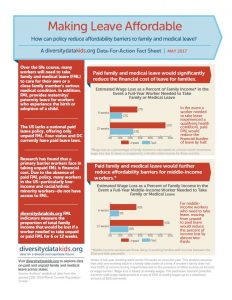
The birth or adoption of a child, the serious illness of a parent, one’s own health emergency. There are health and medical occasions, both joyous and difficult, which require workers to take time off to care and heal. Yet not all people can take the time they need.
Nearly all industrialized nations recognize the necessity of time by guaranteeing paid family and medical leave. The U.S. does not. Paid family and medical leave policy provides extended partially paid time off from work in the event of workers’ own or a close family member’s serious medical condition. A growing number of U.S. workers have access to paid family and medical leave from state or local polices or through their employers. However, most workers do not have access to any paid family or medical leave.
Although the U.S. lacks national paid family and medical leave policy, it does have national unpaid leave. In 1993 the U.S. passed the Family and Medical Leave Act (FMLA), an important law which guarantees twelve weeks of unpaid family and medical leave for qualifying employees who need to provide care for themselves or a close family member.
In the event they need to take family and medical leave, the FMLA provides eligible employees with two primary protections: retention of health insurance (if insurance is provided by the employer) and job protection, meaning that upon return from leave employees are restored to the same or an equivalent position. A key caveat of the FMLA is that most workers do not meet the eligibility requirements necessary to gain access to these protections. At diversitydatakids.org, our research finds that that less than half (45 percent) of all workers (including the self-employed) are eligible for FMLA and that there are inequities in eligibility.
Beyond eligibility, for many families, forgoing pay for up to 12 weeks, even in the midst of serious health needs, is highly unrealistic. Workers may rely on sick days, vacation time, or other types of paid time off, but not all workers have access to these benefits, which are not designed to provide workers with extended time off. Research shows that the financial cost of family and medical leave is a primary barrier workers face as they make leave choices.
Our new fact sheet from diversitydatakids.org explores how paid family and medical leave policy could reduce cost barriers to leave for U.S. working families. This research answers several important questions related to the affordability of family and medical leave.
How much does unpaid family and medical leave cost families in the event they need it?
Taking unpaid family and medical leave, in the event that it is needed, results in a large financial burden for families. Six weeks of unpaid family and medical leave results in a 27 percent loss of family income over a three-month period (i.e. quarterly income) for U.S. full-year workers. The financial shock of family and medical leave is even greater if a worker needs to take 12 weeks of unpaid leave: on average he/she loses well over half of quarterly family income.
Are there alternatives to unpaid family and medical leave that could be implemented in the U.S.?
As an alternative to national unpaid family and medical leave that would bring the U.S. in line with other industrialized nations, the U.S. could offer paid leave through a social insurance policy approach (similar to the approach taken by Social Security programs). Employers and workers would jointly finance an insurance fund which workers would then draw from if they experienced a qualifying health condition and needed to take family and medical leave. While on leave, workers would receive partial wage replacement (maximums would be set for both the benefit amount and the number of weeks of leave). While social insurance does impose a cost on employers in addition to employees, studies of existing state paid family and medical leave insurance programs have found minimal perceived negative impact on businesses.
As proposed in pending federal legislation, a paid family and medical leave social insurance approach that based eligibility on the parameters set by Social Security Disability Insurance would increase eligibility rates for paid leave in the U.S. to 89 percent of the working-age population.
How would paid family and medical leave help families?
Currently four states and the District of Columbia have paid leave insurance laws. If we apply the New Jersey family and medical leave policy to U.S. workers (66 percent wage replacement up to a maximum of $633 per week) income losses would be reduced by half. Rather than lose 27 percent of income for six weeks of unpaid family and medical leave during a three month period, families would lose just 12 percent. Loss of income for 12 weeks of family and medical leave would be reduced from 55 percent of quarterly family income to 23 percent of family income. For middle-income workers the benefits of paid family and medical leave are even greater: it would reduce affordability constraints by almost two-thirds.
Public Policy Options
Recent public opinion surveys indicate broad public support for a social insurance paid leave policy in the U.S.: over three quarters of voters support a federal law establishing a fund that would offer all workers 12 weeks of paid family and medical leave. Paid family and medical leave is a popularly supported program and there is pending legislation in the U.S. Senate that would establish a family and medical leave insurance program to provide for families in times of health crises.
People need support to maintain employment during health crises or when they become parents; it’s about time the U.S. provides it.
Maura Baldiga is a Research Associate and Pamela Joshi is Associate Director and Senior Scientist at the Institute for Child, Youth and Family Policy at the Heller School for Social Policy and Management at Brandeis University. Their research focuses on family economic security and access to work and family policies.

Comments